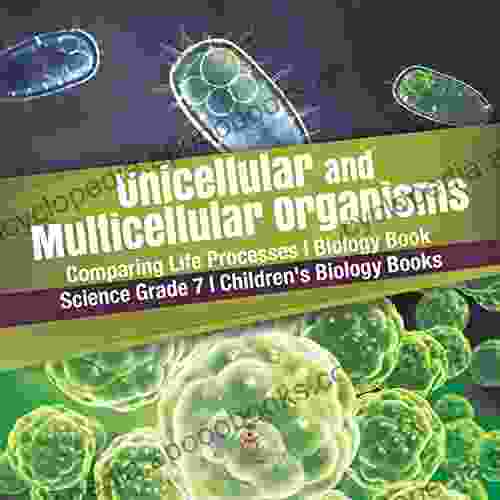Unicellular and Multicellular Organisms: Comparing Life Processes

The world of organisms is vast and diverse, ranging from microscopic bacteria to towering trees. Among this incredible array of life, two fundamental types of organisms stand out: unicellular and multicellular. Unicellular organisms, as their name suggests, consist of a single cell that performs all necessary life functions. Multicellular organisms, on the other hand, are made up of numerous cells that work together in a coordinated fashion to carry out life processes.
4.4 out of 5
| Language | : | English |
| File size | : | 24359 KB |
| Screen Reader | : | Supported |
| Print length | : | 72 pages |
In this article, we will delve into the fascinating world of unicellular and multicellular organisms, comparing their life processes and highlighting their unique characteristics. By exploring the similarities and differences between these two fundamental types of life, we will gain deeper insights into the intricacies of biological organization and the astonishing diversity of living organisms on Earth.
Cell Structure and Function
One of the most fundamental differences between unicellular and multicellular organisms lies in their cell structure and function. Unicellular organisms, such as bacteria and protozoa, are typically much smaller than multicellular organisms and possess a simpler cellular structure. Their cells contain all the necessary organelles for life, including a nucleus, ribosomes, mitochondria, and a cell membrane. However, unicellular organisms lack the complex internal organization and specialized structures found in multicellular organisms.
Multicellular organisms, on the other hand, display a wide range of cell types, each with its own specialized structure and function. For example, nerve cells transmit electrical signals, muscle cells contract to facilitate movement, and epithelial cells provide protection and support. Multicellular organisms also possess specialized tissues, such as muscle tissue, nervous tissue, and epithelial tissue, which are composed of similar cells that work together to perform a specific function.
Cell Division
Cell division is essential for the growth, development, and reproduction of both unicellular and multicellular organisms. In unicellular organisms, cell division is the primary means of reproduction. When a unicellular organism reaches a certain size or undergoes certain environmental cues, it will divide into two daughter cells. This process of binary fission results in two genetically identical offspring.
In multicellular organisms, cell division is essential for growth and development. During embryonic development, the fertilized egg undergoes repeated cell divisions, forming a multicellular embryo. As the embryo grows, cells continue to divide and differentiate, giving rise to the various tissues and organs of the body. In adult multicellular organisms, cell division is limited to specific tissues, such as the skin and the lining of the digestive tract, where cells are constantly replaced as they are damaged or worn out.
Growth and Development
Unicellular organisms grow by increasing their cell size or by dividing into new cells. As they grow, they may undergo changes in their metabolism and behavior to adapt to their changing needs and environment. Multicellular organisms, on the other hand, undergo a more complex process of growth and development. They start as a fertilized egg, which undergoes repeated cell divisions to form a multicellular embryo. The embryo then undergoes a series of developmental stages, forming tissues, organs, and eventually a fully formed organism.
Reproduction
Unicellular organisms reproduce asexually, typically by binary fission. Binary fission involves the splitting of the parent cell into two daughter cells. Each daughter cell receives one copy of the parent cell's genetic material and becomes a genetically identical offspring. Multicellular organisms, on the other hand, can reproduce asexually or sexually. Asexual reproduction involves the formation of offspring from a single parent without the fusion of gametes. Sexual reproduction involves the fusion of gametes (eggs and sperm) from two parents.
Unicellular and multicellular organisms represent two fundamental types of life on Earth, each with its own unique characteristics and life processes. Unicellular organisms, with their simple cell structure and asexual reproduction, have thrived for billions of years. Multicellular organisms, with their complex internal organization and diverse cell types, have evolved to occupy a wide range of habitats and dominate the Earth's biosphere.
By comparing the life processes of unicellular and multicellular organisms, we gain a deeper appreciation for the astonishing diversity of life on our planet.
4.4 out of 5
| Language | : | English |
| File size | : | 24359 KB |
| Screen Reader | : | Supported |
| Print length | : | 72 pages |
Do you want to contribute by writing guest posts on this blog?
Please contact us and send us a resume of previous articles that you have written.
 Book
Book Novel
Novel Page
Page Chapter
Chapter Text
Text Story
Story Genre
Genre Reader
Reader Library
Library Paperback
Paperback E-book
E-book Magazine
Magazine Newspaper
Newspaper Paragraph
Paragraph Sentence
Sentence Bookmark
Bookmark Shelf
Shelf Glossary
Glossary Bibliography
Bibliography Foreword
Foreword Preface
Preface Synopsis
Synopsis Annotation
Annotation Footnote
Footnote Manuscript
Manuscript Scroll
Scroll Codex
Codex Tome
Tome Bestseller
Bestseller Classics
Classics Library card
Library card Narrative
Narrative Biography
Biography Autobiography
Autobiography Memoir
Memoir Reference
Reference Encyclopedia
Encyclopedia Valerie Ogden
Valerie Ogden Mj Fields
Mj Fields 4th Edition Kindle Edition
4th Edition Kindle Edition Stephen Lockyer
Stephen Lockyer Kathy Kimbray
Kathy Kimbray Carole Lawrence
Carole Lawrence Kenneth Anderson
Kenneth Anderson Hope Edelman
Hope Edelman Niki Behrikis Shanahan
Niki Behrikis Shanahan K L Ramsey
K L Ramsey William Blake
William Blake Vikram Sampath
Vikram Sampath Leigh A Bortins
Leigh A Bortins Jean Carruthers
Jean Carruthers 2 Subnd Edition Kindle Edition
2 Subnd Edition Kindle Edition A G Roderick
A G Roderick Margaret M Chin
Margaret M Chin Maria El Aaraj
Maria El Aaraj A E Dimond
A E Dimond Kenneth W Moffett
Kenneth W Moffett
Light bulbAdvertise smarter! Our strategic ad space ensures maximum exposure. Reserve your spot today!
 Martin CoxFollow ·15.4k
Martin CoxFollow ·15.4k Camden MitchellFollow ·14.2k
Camden MitchellFollow ·14.2k Jessie CoxFollow ·15.1k
Jessie CoxFollow ·15.1k Evan SimmonsFollow ·11.7k
Evan SimmonsFollow ·11.7k Roy BellFollow ·3.5k
Roy BellFollow ·3.5k Elton HayesFollow ·15.3k
Elton HayesFollow ·15.3k Reginald CoxFollow ·8.5k
Reginald CoxFollow ·8.5k Clarence MitchellFollow ·6.2k
Clarence MitchellFollow ·6.2k

 Jacob Hayes
Jacob HayesUnlock the Power of Microsoft Word: A Comprehensive Guide...
Microsoft Word is a widely used word...

 Hunter Mitchell
Hunter MitchellAndrea Carter and the Price of Truth: A Thrilling...
Get ready for an unforgettable...

 Ivan Turner
Ivan TurnerTrading Jeff and His Dog: An Unforgettable Adventure of...
Get ready for an emotional rollercoaster...

 Langston Hughes
Langston HughesGo Viral TikTok: The Ultimate Guide to Gaining 100K...
TikTok has emerged as a social...

 Ibrahim Blair
Ibrahim BlairUnveil the Enchanting Realm of Short Fiction: Dive into...
Delve into a Literary Tapestry of...

 Tennessee Williams
Tennessee WilliamsUnveil the Enchanting World of Elizabeth Barrett...
A Poetic Tapestry of Love, Loss, and...
4.4 out of 5
| Language | : | English |
| File size | : | 24359 KB |
| Screen Reader | : | Supported |
| Print length | : | 72 pages |












